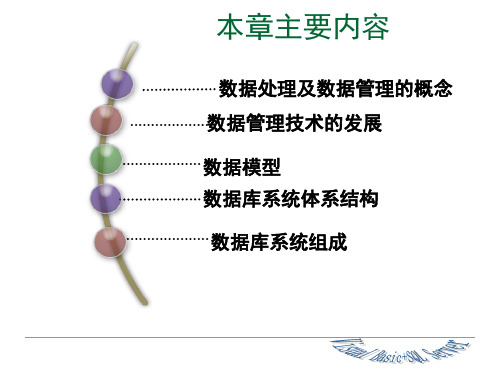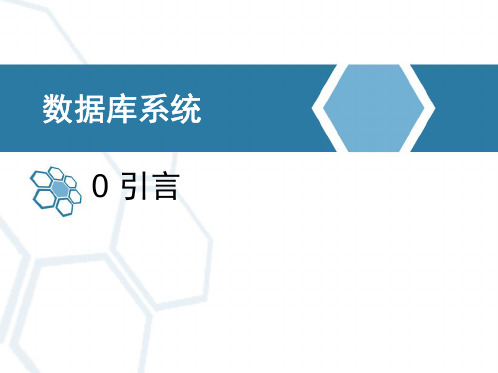浙江大学数据库系统概念PPT第十六章
合集下载
浙江大学数据库系统概念PPT第十六章

Two-Phase Locking is a protocol which ensures conflictserializable schedules.
Phase 1: Growing Phase ➢ transaction may obtain locks ➢ transaction may not release locks
Graph-Based Locking Protocol – Tree protocol
Maintain partial ordering of all data items. Only X lock Guarantee conflict serializable
Timestamp-Based Protocol Validation-Based Protocol
Database System Concepts 3rd Edition
16.11
©Silberschatz, Korth and Sudarshan, Bo Zhou
Automatic Acquisition of Locks
(Commercial DBMS Uses)
A transaction Ti issues the standard read/write instruction, without explicit locking calls.
The operation read(D) is processed as: if Ti has a lock on D then read(D) else begin if necessary wait until no other transaction has a lock-X on D grant Ti a lock-S on D; read(D) end
Phase 1: Growing Phase ➢ transaction may obtain locks ➢ transaction may not release locks
Graph-Based Locking Protocol – Tree protocol
Maintain partial ordering of all data items. Only X lock Guarantee conflict serializable
Timestamp-Based Protocol Validation-Based Protocol
Database System Concepts 3rd Edition
16.11
©Silberschatz, Korth and Sudarshan, Bo Zhou
Automatic Acquisition of Locks
(Commercial DBMS Uses)
A transaction Ti issues the standard read/write instruction, without explicit locking calls.
The operation read(D) is processed as: if Ti has a lock on D then read(D) else begin if necessary wait until no other transaction has a lock-X on D grant Ti a lock-S on D; read(D) end
数据库系统基本概念课件

第三方监控工具
如New Relic、Dynatrace等,提供更全面、灵活的数据库性能监控和报警功能 ,支持多种数据库平台。
THANKS
感谢观看
数据库系统基本概念课件
• 数据库系统概述 • 数据模型与数据结构 • 数据库设计与管理 • 查询语言与优化技术 • 数据库事务处理与并发控制 • 备份恢复与性能监控
01
数据库系统概述
定义与发展历程
数据库定义
数据库是一个长期存储在计算机 内、有组织的、可共享的、统一 管理的大量数据的集合。
发展历程
数据独立性
数据和程序相互独立,数据的 逻辑结构和物理结构的变化不 影响应用程序。
安全性与完整性
数据库系统提供了数据的安全 性控制和完整性约束,保证了
数据的正确性和可靠性。
应用领域及现状
应用领域
广泛应用于金融、制造、物流、医疗、教育、科研等各个领域,成为信息化社 会的重要基础设施。
现状
随着大数据、云计算、人工智能等技术的快速发展,数据库系统面临着新的挑 战和机遇,如分布式数据库、云数据库、时序数据库等新型数据库不断涌现。
访问控制
通过设置用户角色和权限 ,限制用户对数据库的访 问和操作,防止未经授权 的访问和数据篡改。
数据备份与恢复
定期对数据库进行备份, 确保在数据丢失或损坏时 能够恢复数据,保障业务 的正常运行。
04
查询语言与优化技术
SQL查询语言基础
SQL概述
介绍SQL语言的发展、特点及应用领域。
数据查询语言(DQL)
经历了人工管理、文件系统、数 据库系统三个阶段,目前正向大 数据、云计算、人工智能等方向 发展。
数据库系统特点与优势
数据结构化
如New Relic、Dynatrace等,提供更全面、灵活的数据库性能监控和报警功能 ,支持多种数据库平台。
THANKS
感谢观看
数据库系统基本概念课件
• 数据库系统概述 • 数据模型与数据结构 • 数据库设计与管理 • 查询语言与优化技术 • 数据库事务处理与并发控制 • 备份恢复与性能监控
01
数据库系统概述
定义与发展历程
数据库定义
数据库是一个长期存储在计算机 内、有组织的、可共享的、统一 管理的大量数据的集合。
发展历程
数据独立性
数据和程序相互独立,数据的 逻辑结构和物理结构的变化不 影响应用程序。
安全性与完整性
数据库系统提供了数据的安全 性控制和完整性约束,保证了
数据的正确性和可靠性。
应用领域及现状
应用领域
广泛应用于金融、制造、物流、医疗、教育、科研等各个领域,成为信息化社 会的重要基础设施。
现状
随着大数据、云计算、人工智能等技术的快速发展,数据库系统面临着新的挑 战和机遇,如分布式数据库、云数据库、时序数据库等新型数据库不断涌现。
访问控制
通过设置用户角色和权限 ,限制用户对数据库的访 问和操作,防止未经授权 的访问和数据篡改。
数据备份与恢复
定期对数据库进行备份, 确保在数据丢失或损坏时 能够恢复数据,保障业务 的正常运行。
04
查询语言与优化技术
SQL查询语言基础
SQL概述
介绍SQL语言的发展、特点及应用领域。
数据查询语言(DQL)
经历了人工管理、文件系统、数 据库系统三个阶段,目前正向大 数据、云计算、人工智能等方向 发展。
数据库系统特点与优势
数据结构化
浙江大学数据库系统概念

ê i n c r e a s e d p r o c e s s o r and d i s k u t i l i z a t i o n , l e a d i n g t o b e tte r transaction throughput: one transaction can be using t h e CPU while another i s reading from or w r i t i n g t o the disk ê reduced average response time for transactions: short transactions need not wait behind long ones.
ê A transaction must see a consistent database.
ê During transaction execution the database may be inconsistent.
ê When the transaction i s committed, the database must be consistent.
n Durability. After a transaction completes s u c c e s s f u l l y , t h e changes i t has made t o t h e database p e r s i s t , even i f there are system f a i l u r e s .
ê Commit a t r a n s a c t i o n ê Rollback a transaction n Consistency. Execution of a transaction in isolation preserves the consistency of the database.
ê A transaction must see a consistent database.
ê During transaction execution the database may be inconsistent.
ê When the transaction i s committed, the database must be consistent.
n Durability. After a transaction completes s u c c e s s f u l l y , t h e changes i t has made t o t h e database p e r s i s t , even i f there are system f a i l u r e s .
ê Commit a t r a n s a c t i o n ê Rollback a transaction n Consistency. Execution of a transaction in isolation preserves the consistency of the database.
数据库系统设计概述PPT课件

总结词
概念数据模型是一种高层次的抽象表示,用于描述数据的概 念和结构。
详细描述
概念数据模型也称为数据模型或E-R模型,它以图形化的方式 表示实体、实体之间的关系以及实体的属性。常见的概念数 据模型包括实体-联系图、ER图等。
逻辑数据模型
总结词
逻辑数据模型是一种中层次的抽象表 示,用于描述数据的逻辑结构和操作 。
04
数据库系统的体系结构
单用户数据库系统体系结构
总结词
单用户数据库系统体系结构是指数据库系统只允许一个用户进行操作,数据共享性差。
详细描述
在这种体系结构下,数据库系统只配备一台计算机,所有的数据处理和存储都在同一台 计算机上完成。由于只有一个用户能够访问数据库,所以数据共享性较差,数据处理效
率较低。
根据数据存储方式的不同,数据库系统可以分为集中式数据库和分布式数据库。集中式数据库将所有 数据存储在单个高可用节点上;分布式数据库则将数据分散存储在多个节点上,以提高可扩展性和容 错性。
02
数据库系统设计
数据库系统设计的基本原则
完整性
确保数据的准确性和一 致性,满足业务规则和
约束条件。
安全性
保护数据不被未经授权 的访问、修改或破坏。
安全性
随着网络安全问题的日益突出,数据 库系统的安全性将得到更加重视,加 强数据加密和安全防护措施。
数据库系统的研究热点高效地存储和管理大规模数据是当前 数据库领域的研究热点之一。
如何快速查询大规模数据并提高查询效率 是数据库领域的研究热点之一。
数据挖掘与机器学习
分布式数据库系统
主从式数据库系统体系结构
总结词
主从式数据库系统体系结构是指数据库系统由一台主服务器和多台从服务器组成,主服务器负责处理事务,从服 务器负责存储数据。
数据库系统的基本概念优秀课件

信息以数据的形式处理,而处理的结果又可能产生新的信息。
1.1.2 数据处理
数据处理是指对各种形式的数据进行收集、存储、加工和传播的一系列 活动的总和。其目的是从大量的、原始的数据中抽取、推导出对人们有 价值的信息以作为行动和决策的依据;数据处理从根本上来说是为了借 助计算机科学地保存和管理大量复杂的数据,以便人们能够充分地利用 这些宝贵的信息资源。
在数据处理的一系列活动中,数据的收集、组织、存储、传播、检索和 分类等活动是基本环节,这些基本环节统称为数据管理或信息管理。在 数据处理中,对数据的加工、计算、打印报表等操作对不同的业务部门 可以有不同的内容。数据库技术所研究的问题就是如何科学地组织和存 储数据,如何高效地获取和处理数据。数据库技术是数据管理的最新技 术。数据库系统是当代计算机系统的重要组成部分。
数据库系统的基本概念
第1章 数据库系统的基本概念
教学提示:本章主要介绍数据库系统的基本概念, 包括数据与信息的概念;数据管理技术的发展阶段; 数据模型的两个层次;数据库系统的体系结构及数 据库系统的组成。
教学目标:了解数据、信息及其联系与区别;数据 管理技术发展的三个阶段及其特点;掌握概念数据 模型与结构数据模型的基本概念;掌握数据库系统 的三级模式、两级映像及两级独立性。
第1章 数据库系统的基本概念
1.1 信息、数据与数据处理 1.2 数据管理技术的发展 1.3 数据模型 1.4 数据库系统的体系结构 1.5 数据库系统 1.6 习题
1.1 信息、数据与数据处理
1.1.1 信息与数据 1.1.2 数据处理
1.1 信息、数据与数据处理
在科学、技术、经济、文化和军事等各个领域里,我们会遇 到大量的数据,这些数据不但复杂,而且数据量大,因此如 何科学地管理数据是一个极为重要的课题。
1.1.2 数据处理
数据处理是指对各种形式的数据进行收集、存储、加工和传播的一系列 活动的总和。其目的是从大量的、原始的数据中抽取、推导出对人们有 价值的信息以作为行动和决策的依据;数据处理从根本上来说是为了借 助计算机科学地保存和管理大量复杂的数据,以便人们能够充分地利用 这些宝贵的信息资源。
在数据处理的一系列活动中,数据的收集、组织、存储、传播、检索和 分类等活动是基本环节,这些基本环节统称为数据管理或信息管理。在 数据处理中,对数据的加工、计算、打印报表等操作对不同的业务部门 可以有不同的内容。数据库技术所研究的问题就是如何科学地组织和存 储数据,如何高效地获取和处理数据。数据库技术是数据管理的最新技 术。数据库系统是当代计算机系统的重要组成部分。
数据库系统的基本概念
第1章 数据库系统的基本概念
教学提示:本章主要介绍数据库系统的基本概念, 包括数据与信息的概念;数据管理技术的发展阶段; 数据模型的两个层次;数据库系统的体系结构及数 据库系统的组成。
教学目标:了解数据、信息及其联系与区别;数据 管理技术发展的三个阶段及其特点;掌握概念数据 模型与结构数据模型的基本概念;掌握数据库系统 的三级模式、两级映像及两级独立性。
第1章 数据库系统的基本概念
1.1 信息、数据与数据处理 1.2 数据管理技术的发展 1.3 数据模型 1.4 数据库系统的体系结构 1.5 数据库系统 1.6 习题
1.1 信息、数据与数据处理
1.1.1 信息与数据 1.1.2 数据处理
1.1 信息、数据与数据处理
在科学、技术、经济、文化和军事等各个领域里,我们会遇 到大量的数据,这些数据不但复杂,而且数据量大,因此如 何科学地管理数据是一个极为重要的课题。
《数据库系统概述》课件

关系数据库
关系数据库
一种基于关系的数据库,通过表 格的形式来组织数据,每个表格 包含若干行和列,每列代表一个 属性,每行代表一个记录。
关系完整性
关系数据库中的数据完整性是指 数据的正确性和一致性,包括实 体完整性、参照完整性和用户自 定义完整性。
关系代数
一种用于描述关系数据库中数据 操作的数学模型,包括选择、投 影、连接等操作。
事务管理
确保数据完整性的重要手段之一,通过事务来保证 一系列操作要么全部成功执行,要么全部不执行。
并发控制
在多用户并发访问数据库时,通过各种并发 控制技术来保证数据的一致性和完整性。
03
数据库系统设计
数据库设计的基本原则
确保数据完整性
设计时应考虑数据的准确性、一致性和完整 性,避免数据冗余和冲突。
优化查询语句,避免全表扫描,减 少不必要的计算和数据传输。
缓存技术
利用缓存存储常用数据,减少对数 据库的访问次数。
04
数据库系统的备份与恢复
备份策略
制定定期备份和增量备份策略,确保数据安 全。
备份存储
选择可靠的存储介质和设备,确保备份数据 不会丢失。
数据恢复
在数据丢失或损坏时,能够快速恢复数据, 减少业务中断时间。
等。
02
数据库系统基本概念
数据模型
概念模型
数据模型的一种,用于描述现实世界事物以及事物之间的 关系,常见的概念模型有实体-联系模型(E-R模型)。
逻辑模型
数据模型的一种,用于描述数据结构、数据操作和数据约 束,常见的逻辑模型有层次模型、网状模型和关系模型。
物理模型
数据模型的一种,用于描述数据存储和数据访问方式,常 见的物理模型有B树、B+树等。
数据库系统概述PPT课件

19.04.2020
15
人工管理阶段 文件系统阶段 数据库系统阶段
19.04.2020
数据不保存,不共享,无独立性, 无专用软件管理数据
数据以文件形式长期保存,由文件系统管理 数据 ,程序与数据间有一定独立性
数据结构化 ,共享性高、冗余度低 , 独立性高 ,有统一的数据控制功能
数据的安全性控制 数据的完整性控制
第1章 数据库系统概述
数据库
数据的仓库,即数据存放的地方
通讯录: 图书馆:
小数据库 可用手工管理
大型数据库 必须由计算机进行管理
科学计算
计算机三大主 要应用领域?
过程控制 数据处理
70% 利用数据库系统可
科学地组织和存储
数据,以便于高效地
19.04.2020
检索和处理
2
1.1 信息、数据、数据处理与数据管理 1.1.1 数据与信息
特点
数据存放在文件中,应用程序通过文件名来逻辑地 访问文件。
有了管理数据的软件——文件系统,文件的物理存 储由文件系统管理,文件系统还负责对文件的逻辑 结构与存储结构进行转换。
程序和数据有了一定的独立性。程序不再负责数据 存储的物理细节,因此可大大节省维护程序的工作 量,程序员也可不必过多地考虑物理细节,可把精 力集中在算法上。
数据的存取基本上以记录为单位。按文件名访问, 按记录进行存取。
19.04.2020
9
文件系统阶段:应用程序与数据的关系
程序1
数据缓冲区
文
内存
程序2
件
数据缓冲区
系
统
程序3 数据缓冲区
外存 文件1 文件2 文件3
19.04.2020
10
浙江大学数据库系统概念PPT第十六章

Control
• Lock-Based Protocols • Multiple Granularity • Deadlock Handling • Insert and Delete Operations • Concurrency in Index
Structures
2020/5/24
Lock-Based Protocols
• Cascading roll-back is possible under two-phase locking. To avoid this, follow a modified protocol called strict twophase locking. Here a transaction must hold all its exclusive locks till it commits/aborts.
• Lock 2020/5/24 requests are made to concurrency-
Lock-Based Protocols (Cont.)
• Lock-compatibility matrix
• A transaction may be granted a lock on an item if the requested lock is compatible with locks already held on the item by other transactions
• Starvation is also possible if concurrency control manager is badly designed. For example:
– A transaction may be waiting for an X-lock on an item, while a sequence of other transactions request and are granted an Slock on the same item.
• Lock-Based Protocols • Multiple Granularity • Deadlock Handling • Insert and Delete Operations • Concurrency in Index
Structures
2020/5/24
Lock-Based Protocols
• Cascading roll-back is possible under two-phase locking. To avoid this, follow a modified protocol called strict twophase locking. Here a transaction must hold all its exclusive locks till it commits/aborts.
• Lock 2020/5/24 requests are made to concurrency-
Lock-Based Protocols (Cont.)
• Lock-compatibility matrix
• A transaction may be granted a lock on an item if the requested lock is compatible with locks already held on the item by other transactions
• Starvation is also possible if concurrency control manager is badly designed. For example:
– A transaction may be waiting for an X-lock on an item, while a sequence of other transactions request and are granted an Slock on the same item.
数据库系统PPT课件

数据库系统的性能优化
查询优化
对数据库查询进行优化,包括索引设计、查询语句优化等, 提高查询速度和效率。
硬件优化
根据数据库系统的负载和性能需求,对硬件资源进行合理 配置和优化,包括内存、CPU、存储等。
系统监控与调优
对数据库系统进行实时监控,发现性能瓶颈并进行调优,确保 数据库系统在高负载情况下仍能保持稳定和高效运行。
数据库系统将数据组织 成有逻辑关系的结构化 形式,方便用户进行查 询、更新和管理。
数据库系统允许多个用 户同时访问和操作数据 ,实现数据共享,提高 数据利用率。
数据库系统通过数据模 型和数据管理技术,使 数据与应用程序相互独 立,减少数据冗余和数 据不一致性。
数据库系统提供数据加 密、权限控制等安全机 制,确保数据不被非法 访问和篡改。
逻辑设计
逻辑模型转换
将概念模型转换为逻辑模型,如关系模型。
逻辑优化
根据数据库性能和功能需求,对逻辑模型进行优化。
物理设计
存储结构
设计数据库的物理存储结构,包括文件组织、存储路径等。
索引策略
根据查询需求,设计合适的索引策略以提高查询效率。
数据库实施与维护
数据导入与迁移
将数据从旧系统迁移到新设计的数据库系统中。
公共服务的开展。
02 数据库系统的基本概念
数据模型
概念模型
数据模型的一种,用于描述现实世界事物以 及事物之间的关系,常见的有实体-关系模 型和ER模型。
逻辑模型
数据模型的一种,用于描述数据结构、数据操作和 数据约束,常见的有层次模型、网状模型和关系模 型。
物理模型
数据模型的一种,用于描述数据存储和数据 访问方式,包括数据存储结构、数据存储路 径、数据访问方法等。
数据库系统基础教程PPT完整版

THANKS FOR WATCHING
感谢您的观看
概念设计的输出
概念设计的输出是概念模型,它为后续的逻辑设计和物理 设计提供了基础。
逻辑设计
逻辑设计的定义
逻辑设计是根据概念设计的结果,将概念模型转换为逻辑模型的过 程。逻辑模型是对数据库结构的详细描述,包括表、视图、索引等。
逻辑设计的方法
逻辑设计通常采用关系型数据库管理系统(RDBMS)来实现,包 括表的设计、关系的定义、约束的添加等。
数据库系统的维护与优化
数据库备份与恢复
定期备份数据库,确保在数据丢失或损坏时能够 恢复。
数据库安全更新与补丁
及时更新数据库系统和应用软件,修补安全漏洞。
ABCD
性能监控与调优
监控数据库性能,通过调整参数和优化查询等方 式提高性能。
数据库系统硬件与软件的维护
定期检查硬件和软件的运行状况,确保数据库系 统的稳定运行。
格式。
模式
02
也称为逻辑模式,描述了数据在数据库中的逻辑结构和关系。
外模式
03
也称为用户模式,描述了数据在用户视角下的表现形式和结构。
03 数据库设计
数据库设计概述
数据库设计定义
数据库设计的基本步骤
数据库设计是指根据特定需求,构建 一个结构合理、性能良好、操作方便 的数据库的过程。
需求分析、概念设计、逻辑设计、物 理设计等。
01
概述
人工智能技术的快速发展对数据库系统产生了深远影响,推动了数据库
系统的智能化进程。
02
挑战
人工智能时代对数据库系统的要求更高,需要具备自适应、自学习、自
推理等能力。
03
技术发展
人工智能技术在数据库系统中的应用不断深入,如机器学习、深度学习、
数据库系统导论PPT课件

(3)用户
用户是指数据库系统的最终用户。不同层次的用户按其业务工作的要求, 通过应用程序的操作界面使用数据库,分别完成日常业务、管理和决策的工作。 如超市的收银员就是一种数据库系统的用户。
参考教材
萨师煊、王珊编著, 数据库系统 (第五版), 高等教育出版社
周立柆等编著,SQL Server 数据库原理— —设计与实现, 清华大学出版
作业
考试以完成实验环节为必要条件,期末考试采用笔试; 本课程总成绩为100分,其中成绩评定由三部分组成: 期末考试成绩: 60% 实验成绩: 25% 平时成绩: 15%
本课程分组实验
分组实验考查:以组为单位,每组设计一个系统,设计工 具:Visual Basic6.0+SqlServer2000
1.2 数据管理技术的发展
1.2.3 数据库系统阶段
3.数据库系统阶段的主要特点
(4)便于对数据实现集中统一的管理与控制
完整性控制 :数据的完整性是指数据的正确性、有 效性。数据库中的数据是对客观世界中事物性质的 反映,必须要符合一定的语义。数据库系统应提供 必要的功能,保证数据库中的数据在输入、修改过 程中始终符合原来的含义或规定。
1.2 数据管理技术的发展
1.2.3 数据库系统阶段
3.数据库系统阶段的主要特点
(4)便于对数据实现集中统一的管理与控制
安全性控制
完整性控制 并发控制
故障恢复
1.2 数据管理技术的发展
1.2.3 数据库系统阶段
3.数据库系统阶段的主要特点
(4)便于对数据实现集中统一的管理与控制
安全性控制:数据的安全性是指保护数据以防止不 合法的使用所造成的数据泄密或破坏。系统一般用 检查口令或其它手段来验证用户身份,只有合法用 户才能进入数据库系统;可以通过定义保密级别和 数据存取权限来控制进入系统的用户只能使用允许 他使用的数据。
用户是指数据库系统的最终用户。不同层次的用户按其业务工作的要求, 通过应用程序的操作界面使用数据库,分别完成日常业务、管理和决策的工作。 如超市的收银员就是一种数据库系统的用户。
参考教材
萨师煊、王珊编著, 数据库系统 (第五版), 高等教育出版社
周立柆等编著,SQL Server 数据库原理— —设计与实现, 清华大学出版
作业
考试以完成实验环节为必要条件,期末考试采用笔试; 本课程总成绩为100分,其中成绩评定由三部分组成: 期末考试成绩: 60% 实验成绩: 25% 平时成绩: 15%
本课程分组实验
分组实验考查:以组为单位,每组设计一个系统,设计工 具:Visual Basic6.0+SqlServer2000
1.2 数据管理技术的发展
1.2.3 数据库系统阶段
3.数据库系统阶段的主要特点
(4)便于对数据实现集中统一的管理与控制
完整性控制 :数据的完整性是指数据的正确性、有 效性。数据库中的数据是对客观世界中事物性质的 反映,必须要符合一定的语义。数据库系统应提供 必要的功能,保证数据库中的数据在输入、修改过 程中始终符合原来的含义或规定。
1.2 数据管理技术的发展
1.2.3 数据库系统阶段
3.数据库系统阶段的主要特点
(4)便于对数据实现集中统一的管理与控制
安全性控制
完整性控制 并发控制
故障恢复
1.2 数据管理技术的发展
1.2.3 数据库系统阶段
3.数据库系统阶段的主要特点
(4)便于对数据实现集中统一的管理与控制
安全性控制:数据的安全性是指保护数据以防止不 合法的使用所造成的数据泄密或破坏。系统一般用 检查口令或其它手段来验证用户身份,只有合法用 户才能进入数据库系统;可以通过定义保密级别和 数据存取权限来控制进入系统的用户只能使用允许 他使用的数据。
《数据库系统概论》课件

数据挖掘技术
数据挖掘是从大量数据中提取有用的信息和知识的过程。数据挖掘技术包括关联分析、聚类分析、分类和预测等 ,可以帮助企业发现隐藏在数据中的价值。
分布式数据库系统
• 分布式数据库系统是一种将数据 存储在多个物理节点上的数据库 系统,每个节点拥有自己的存储 系统和处理能力。分布式数据库 系统可以实现数据的分散存储和 访问,提高数据的可用性和可扩 展性。
数据库
存储数据的物理结构。
查询优化器
优化查询性能,选择最佳的查 询执行计划。
用户界面
提供用户与数据库交互的界面 ,包括命令行界面和图形用户 界面。
06
数据库技术的发展趋 势
数据仓库与数据挖掘技术
数据仓库
数据仓库是一个大型、集中式的存储系统,用于存储和管理大量的数据,以便进行查询、分析和决策支持。数据 仓库技术包括数据清理、数据集成、数据存储和查询优化等技术。
需求分析阶段需要与用户进行深入交流,了解用户的需求和业务场景,并 整理成需求文档。
需求分析阶段还需要对数据进行分类和分析,确定数据的来源、结构和关 系。
概念设计阶段
01 概念设计阶段是根据需求分析的结果,设计出满 足用户需求的数据库概念结构。
02 概念设计阶段主要采用E-R图等工具进行数据模 型的设计,确定实体、属性、关系等概念。
数据的独立性
数据库系统将数据与应用程序分离, 使得数据的修改和应用程序的更新相 互独立。
数据的共享性
数据库系统允许多个用户同时访问和 操作数据,实现数据的共享和协同工 作。
数据库系统的分类
关系数据库系统
基于关系模型的数据库系统, 使用表格形式存储数据,支持
SQL语言进行数据操作。
非关系数据库系统
数据挖掘是从大量数据中提取有用的信息和知识的过程。数据挖掘技术包括关联分析、聚类分析、分类和预测等 ,可以帮助企业发现隐藏在数据中的价值。
分布式数据库系统
• 分布式数据库系统是一种将数据 存储在多个物理节点上的数据库 系统,每个节点拥有自己的存储 系统和处理能力。分布式数据库 系统可以实现数据的分散存储和 访问,提高数据的可用性和可扩 展性。
数据库
存储数据的物理结构。
查询优化器
优化查询性能,选择最佳的查 询执行计划。
用户界面
提供用户与数据库交互的界面 ,包括命令行界面和图形用户 界面。
06
数据库技术的发展趋 势
数据仓库与数据挖掘技术
数据仓库
数据仓库是一个大型、集中式的存储系统,用于存储和管理大量的数据,以便进行查询、分析和决策支持。数据 仓库技术包括数据清理、数据集成、数据存储和查询优化等技术。
需求分析阶段需要与用户进行深入交流,了解用户的需求和业务场景,并 整理成需求文档。
需求分析阶段还需要对数据进行分类和分析,确定数据的来源、结构和关 系。
概念设计阶段
01 概念设计阶段是根据需求分析的结果,设计出满 足用户需求的数据库概念结构。
02 概念设计阶段主要采用E-R图等工具进行数据模 型的设计,确定实体、属性、关系等概念。
数据的独立性
数据库系统将数据与应用程序分离, 使得数据的修改和应用程序的更新相 互独立。
数据的共享性
数据库系统允许多个用户同时访问和 操作数据,实现数据的共享和协同工 作。
数据库系统的分类
关系数据库系统
基于关系模型的数据库系统, 使用表格形式存储数据,支持
SQL语言进行数据操作。
非关系数据库系统
1数据库系统概述《数据库系统》课件 PPT

50年代中期以前 磁带、纸带,无 磁盘
无外存 无软件 无共享
人工管理阶段
2021/7/13
50年代后期到60年 代中期
有外存 数据与程序紧耦合 共享程度低、安全
性差、冗余度高、 并发控制难。
文件系统阶段
数据库原理及应用教程
60年代后期至今 大容量磁盘,硬件
价格下降 软件价格上升,开
…… …… ……
应用程序1 应用程序n
数据集1 一
一
对
数据集n
应
数据库原理及应用教程
14
1.2 数据库技术的产生、发展
1.2.2 文件系统阶段
数据可以长期保存在外存上(保存的要求)
特点
由文件系统管理数据,实现了“按文件名访问,按记录
进行存取”的数据管理技术(检索的要求)
数据与程序有了一定的独立性,设备和数据间具有“设
模式
+具体值
实例(instance)
2021/7/13
数据库原理及应用教程
22
1.4 数据库系统的模式结构
1.4.1 数据库系统的三级模式结构 ANSI将数据库系统内部的体系结构分为三级
应用1 应用2 … 应用n
从用户的角度
外模式1
多个
… 外模式m
用户级
外模式/模式映象
一个
模式
模式/内模式映象
一个
将数据转换成信息的过 程,包括对数据进行收 集、储存、加工和传播 等一系列活动
指数据的收集、整理 、组织、编码、存储 、维护、检索、传输 等操作
信息=数据+数据处理
研究通用、高效、便 捷的管理软件
数据处理
数据管理
管理技术决定处理效率
《数据库系统概念》课件

网状模型
网状模型使用复杂的连接结构,适合描述 多对多的关系。
关系模型
关系模型是最常用的数据库模型,使用表 格形式的关系组织数据。
数据库设计原则
数据规范化
通过数据规范化,将数据 组织成最简洁、高效的形 式。
约束条件
使用约束条件来保证数据 的完整性和一致性。
性能优化
对数据库进行性能优化, 提高查询和操作的效率。
《数据库系统概念》PPT 课件
欢迎来到《数据库系统概念》PPT课件!本课程将带领您了解数据库的基本概 念、数据库管理系统以及关系型数据库等重要主题。
课程介绍
掌握核心概念
学习数据库的基本概念, 包括数据模型、数据结构 和数据操作。
实践应用技能
通过案例和实际练习,掌 握数据库设计和管理的实 际技能。
了解最新趋势
结构化查询语言
关系型数据库使用结构化查 询语言(SQL)进行数据查询和 操作。
ACID特性
关系型数据库具备ACID特性, 保证了数据事务的原子性、 一致性、隔离性和持久性。
数据库模型
层次模型
层次模型使用树状结构来组织数据,适合 描述父子关系。
对象模型
对象模型将数据组织成对象,适合描述面 向对象的系统。
了解数据库发展的最新趋 势,如云计算和大数据。
数据库基本概念
1 数据
2 实体与关系
数据是信息的载体,是数据库的核心组 关系表示实体之间的联系。
3键
4 数据操作
键是用来唯一标识数据库中实体的属性 或属性集。
数据库操作包括查询、插入、更新和删 除等操作。
数据库管理系统
1
结构化数据
数据库管理系统针对结构化数据的存储和管理进行优化。
- 1、下载文档前请自行甄别文档内容的完整性,平台不提供额外的编辑、内容补充、找答案等附加服务。
- 2、"仅部分预览"的文档,不可在线预览部分如存在完整性等问题,可反馈申请退款(可完整预览的文档不适用该条件!)。
- 3、如文档侵犯您的权益,请联系客服反馈,我们会尽快为您处理(人工客服工作时间:9:00-18:30)。
• A locking protocol is a set of rules
2020/6/21
Pitfalls of Lock-Based Protocols
• Consider the partial schedule
• Neither T3 nor T4 can make progress — executing lock-S(B) causes T4 to wait for T3 to release its lock on B, while executing lock-X(A) causes T3 to wait for T4 to release its lock on A.
– 2020/6/21 The same transaction is repeatedly rolled
Protocol
• Two-Phase Locking is a protocol which ensures conflict-serializable schedules.
– Phase 1: Growing Phase
• The protocol assures serializability. It can be proved that the transactions can
be 2020/6/21 serialized in the order of their lock
Protocol (Cont.)
• Two-phase locking does not ensure freedom from deadlocks
• transaction may obtain locks • transaction may not release locks
– Phase 2: Shrinking Phase
• transaction may release locks • transaction may not obtain locks
T2: lock-S(A); read (A); unlock(A); lock-S(B); read (B); unlock(B); display(A+B)
– Locking as above is not sufficient to guarantee serializability — if A and B get updated in-between the read of A and B, the displayed sum would be wrong.
• Lock 2020/6/21 requests are made to concurrency-
Lock-Based Protocols (Cont.)
• Lock-compatibility matrix
• A transaction may be granted a lock on an item if the requested lock is compatible with locks already held on the item by other transactions
• Such a situation is called a deadlock.
– To handle a deadlock one of T3 or T4 must be rolled back and its locks released.
2020/6/21
(Cont.)
• The potential for deadlock exists in most locking protocols. Deadlocks are a necessary evil.
• Cascading roll-back is possible under two-phase locking. To avoid this, follow a modified protocol called strict twophase locking. Here a transaction must hold all its exclusive locks till it commits/aborts.
• A lock is a mechanism to control concurrent access to a data item
• Data items can be locked in two modes : 1. exclusive (X) mode. Data item can be both read as well as written. X-lock is request. 2. shared (S) mode. Data item can only be read. S-lock is requested using lock-S instruction.
• Any number of transactions can hold shared locks on an item, but if any
2020/6/21
Lock-Based Protocols (Cont.)
• Example of a transaction performing locking:
• Starvation is also possible if concurrency control manager is badly designed. For example:
– A transaction may be waiting for an X-lock on an item, while a sequence of other transactions request and are granted an Slock on the same item.
Control
• Lock-Based Protocols • Multiple Granularity • Deadlock Handling • Insert and Delete Operations • Concurrency in Index
Structures
2020/6/21
Lock-Based Protocols
2020/6/21
Pitfalls of Lock-Based Protocols
• Consider the partial schedule
• Neither T3 nor T4 can make progress — executing lock-S(B) causes T4 to wait for T3 to release its lock on B, while executing lock-X(A) causes T3 to wait for T4 to release its lock on A.
– 2020/6/21 The same transaction is repeatedly rolled
Protocol
• Two-Phase Locking is a protocol which ensures conflict-serializable schedules.
– Phase 1: Growing Phase
• The protocol assures serializability. It can be proved that the transactions can
be 2020/6/21 serialized in the order of their lock
Protocol (Cont.)
• Two-phase locking does not ensure freedom from deadlocks
• transaction may obtain locks • transaction may not release locks
– Phase 2: Shrinking Phase
• transaction may release locks • transaction may not obtain locks
T2: lock-S(A); read (A); unlock(A); lock-S(B); read (B); unlock(B); display(A+B)
– Locking as above is not sufficient to guarantee serializability — if A and B get updated in-between the read of A and B, the displayed sum would be wrong.
• Lock 2020/6/21 requests are made to concurrency-
Lock-Based Protocols (Cont.)
• Lock-compatibility matrix
• A transaction may be granted a lock on an item if the requested lock is compatible with locks already held on the item by other transactions
• Such a situation is called a deadlock.
– To handle a deadlock one of T3 or T4 must be rolled back and its locks released.
2020/6/21
(Cont.)
• The potential for deadlock exists in most locking protocols. Deadlocks are a necessary evil.
• Cascading roll-back is possible under two-phase locking. To avoid this, follow a modified protocol called strict twophase locking. Here a transaction must hold all its exclusive locks till it commits/aborts.
• A lock is a mechanism to control concurrent access to a data item
• Data items can be locked in two modes : 1. exclusive (X) mode. Data item can be both read as well as written. X-lock is request. 2. shared (S) mode. Data item can only be read. S-lock is requested using lock-S instruction.
• Any number of transactions can hold shared locks on an item, but if any
2020/6/21
Lock-Based Protocols (Cont.)
• Example of a transaction performing locking:
• Starvation is also possible if concurrency control manager is badly designed. For example:
– A transaction may be waiting for an X-lock on an item, while a sequence of other transactions request and are granted an Slock on the same item.
Control
• Lock-Based Protocols • Multiple Granularity • Deadlock Handling • Insert and Delete Operations • Concurrency in Index
Structures
2020/6/21
Lock-Based Protocols
